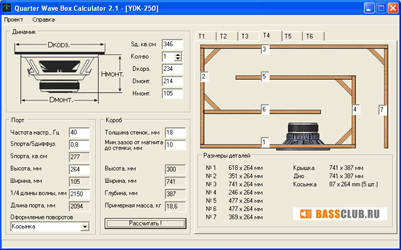Quarter Wave Box Calculator
So, heres the formula, its simple, you would just need a pen, paper, and calculator. Tomb raider 2013 congratulations you have successfully installed downloadable content. I just had to do something on t-line, and explain quarter wave boxes a little.
Quarter Wavelength Loudspeaker Design Quarter Wavelength Loudspeaker Design by Martin J. King, 7/17/2002 (last revised 1/27/2019) Welcome to my quarter wavelength loudspeaker design website. Bootsect zip usbprep8 pe to usb downloads. The most common example of a loudspeaker that relies on a quarter wavelength acoustic standing wave is a transmission line enclosure. This style of loudspeaker has been on the fringe of the audio mainstream for many years with just a few smaller companies building and marketing this enclosure design. Even more exotic and rare in the audio marketplace are the TQWT and the horn loaded enclosure designs.
All of these enclosures utilize acoustic standing waves that can be described as multiples of a quarter cycle of a sine or cosine function. Hence my terminology of a 'Quarter Wavelength Loudspeaker Design' to describe the content of the articles contained in this website. I have been interested in transmission line loudspeakers for almost 25 years. However, for a long time the lack of a proven mathematical model prevented me from actually pursuing and building this style of loudspeaker enclosure. Over the past 15 years, I have built a number of closed and ported box loudspeakers based on the equivalent circuit models descibed by Thiele and Small. About 15 years ago, I decided to try and develop my own mathematical model to simulate transmission line loudspeakers using the MathCad computer program. This decision set off the chain of events that eventually resulted in this website.

My first two quarter wavelength style enclosures were designed mathematically, built, and then final acoustic and impedance measurements were performed. During the process of completing these two loudspeakers, the MathCad models went through a continuous evolution which produced more accurate calculated results leading to better correlations between the predictions and the measurements. Recently, I started building a third type of quarter wavelength enclosure that is difficult for me to classify. From the outside it would appear to be a bass reflex enclosure. But acoustically, quarter wavelength standing waves inside the enclosure are used to produce the bass response emanating from the port. Is this project a mass loaded transmission line design or a bass reflex design?
I am not so sure, the differences are starting to get very fuzzy. Some information on this type of speaker is also included in the projects section of this website. The newest versions of the MathCad worksheets are based on a calculation algorithm that is proving to be extremely flexible. This flexibility has allowed me to extend the original transmission line models to simulate a wide variety of enclosure styles.